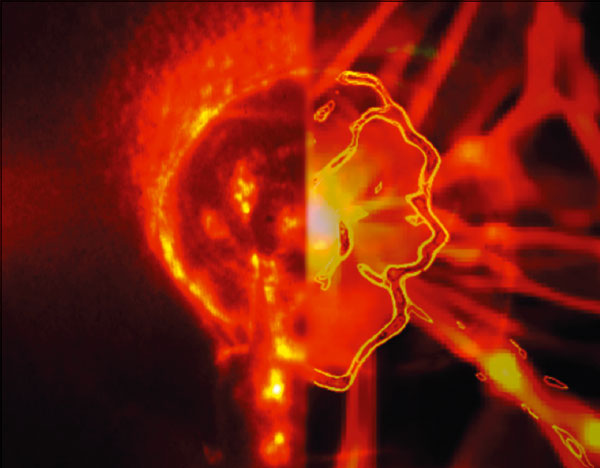
Image credit: F Miniati/ETH.
How did magnetic fields arise in the universe? An experiment using a high-power laser to create plasma instabilities may have glimpsed the processes that created magnetic fields during the period of galaxy formation.
Magnetic fields pervade the cosmos. Measurements of synchrotron emission at radio frequencies from cosmic rays and of Faraday rotation reveal that they exist in Galaxy clusters on the megaparsec scale, with strengths that vary from a few nanogauss to a few microgauss. Intergalactic magnetic fields weave through clusters of galaxies forming even larger-scale structures. In these clusters the temperatures can often be greater than 108 K, making them strong X-ray emitters. It is possible that the energy to heat the plasma comes from the magnetic field through some plasma instability. In general, wherever intergalactic hot matter is detected, magnetic fields with strengths greater than 10–9 G are also observed – with weaker magnetic fields tending to occur outside galaxy clusters. The magnetic field therefore appears to play a role in the structure of the universe.
The only way to explain the observed magnetization is through a magnetic dynamo mechanism in which it is necessary to invoke a “seed” field – but the origin of this seed field remains a puzzle. Prior to galaxy formation, density inhomogeneities would drive violent motions in the universe, forming shock waves that would generate vorticity on all scales. In 1997 Russell Kulsrud suggested that the “Biermann battery effect” could create seed magnetic fields as small as 10–21 G that would be amplified by the protogalaxy dynamo. In this effect, proposed by astrophysicist Ludwig Biermann in 1950, electric fields can arise in a plasma as the electrons and the heavier protons respond differently to external pressure and tend to separate. The Biermann battery acts to create the seed magnetic fields whenever the pressure and density gradients are not parallel.
Now, an international team of scientists has performed an experiment to recreate the conditions similar to those in the pregalactic epoch where shocks and turbulent motions form. They used a high-power laser at the Laboratoire pour l’Utilisation des Lasers Intenses in Paris to explode a rod of carbon surrounded by helium gas in a field-free environment. Magnetic induction coils monitored the magnetic fields created in the resulting shock waves. The team found that the explosion generated strong shock waves around which strong electric currents and magnetic fields formed, through the Biermann battery effect, with fields as high as 10–30 G existing for 1–2 μs at 3 cm from the blast. When scaled through 22 orders of magnitude, the measurements matched the predynamo magnetic seeds predicted by theory prior to galaxy formation.
Further reading
Gianluca Gregori et al. 2012 Nature 481 480.





